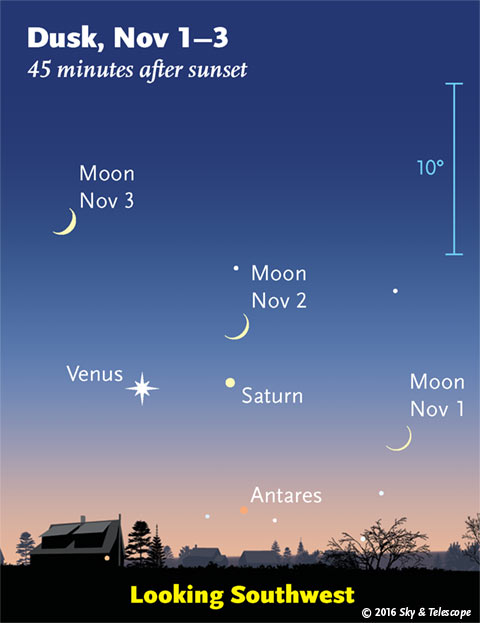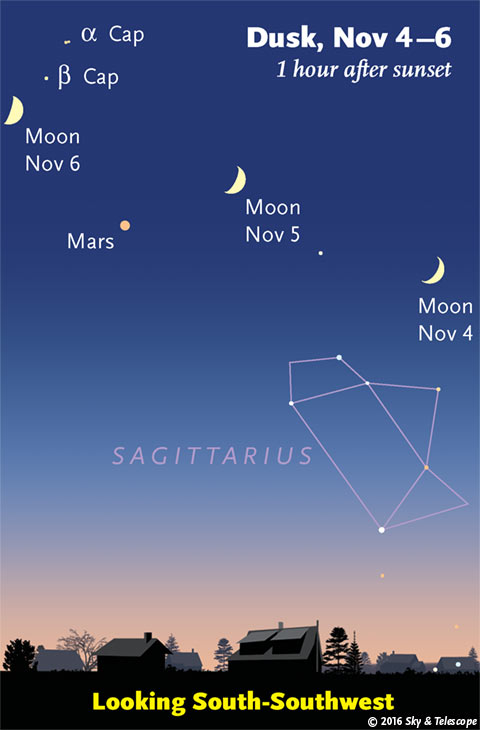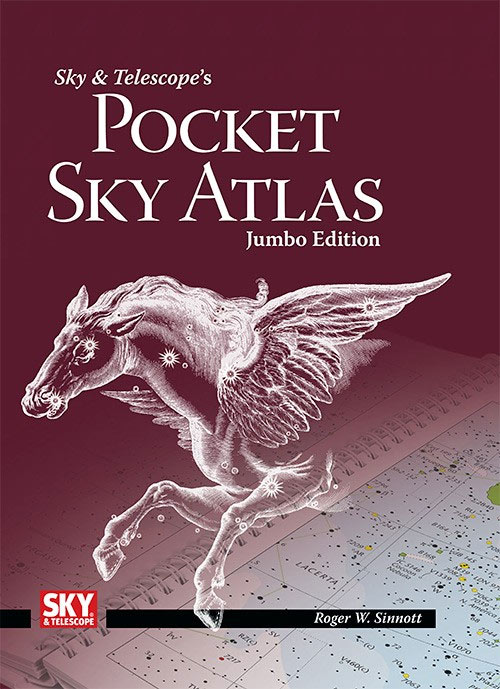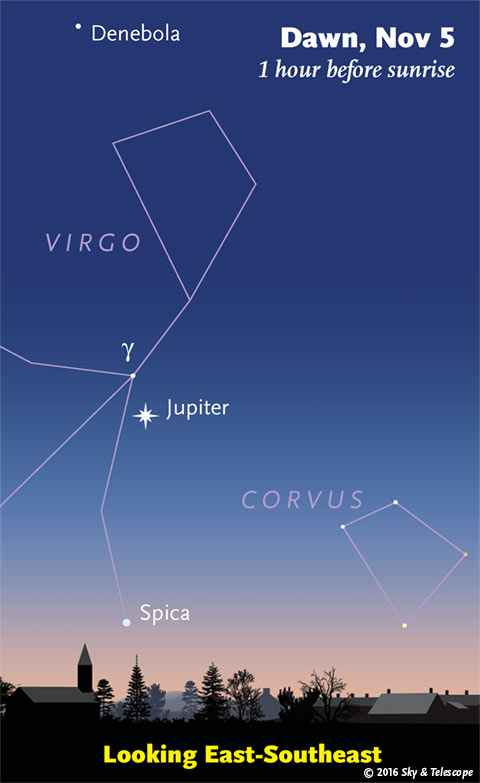Astronomy - This Week’s Sky at a Glance, October 28 – November 5

As the Moon comes back into the evening sky, it waxes past Saturn and Venus. . .

. . .and as it waxes further, the Moon passes Mars.
Friday, October 28
• In twilight this evening, Saturn, brilliant Venus, and Antares form a nearly vertical, curving line low in the southwest — in that order top to bottom. Yesterday they formed an almost straight line.
Watch their configuration change rapidly day by day, as Venus speeds eastward (upper left) with respect to the other two. By Wednesday November 2nd they'll form almost a right triangle, as shown at right.
Saturday, October 29
• The Ghost of Summer Suns. Halloween is approaching, and this means that Arcturus, the star sparkling low in the west-northwest in twilight, is taking on its role as "the Ghost of Summer Suns." For several days centered on October 29th every year, Arcturus occupies a special place above your local landscape. It closely marks the spotwhere the Sun stood at the same time, by the clock, during hot June and July — in broad daylight, of course.
So, in the last days of October each year, you can think of Arcturus as the chilly Halloween ghost of the departed summer Sun, sinking low and setting after dinnertime.
Sunday, October 30
• Spot bright Altair high in the southwest soon after dark. Two distinctive little constellations glimmer above it: Delphinus the Dolphin, hardly more than a fist at arm's length to Altair's upper left, and fainter Sagitta the Arrow, slightly closer to Altair's upper right. In your sky too bright for them? Use binoculars.
• New Moon (exact at 1:38 p.m. EDT).
Monday, October 31
• There's no Moon this Halloween. Vega is the brightest star high in the west. Less high in the southwest is Altair, not quite as bright. Just upper right of Altair, by a finger-width at arm's length, is orange Tarazed, looking like Altair's little sidekick but actually a much bigger and brighter star far in the background. Altair is 17 light-years away. Tarazed is about 360 light-years away, and it's 100 times as luminous!
Tuesday, November 1
• Venus, Saturn, and the thin crescent Moon shine through the fading twilight low in the southwest, as shown at the top of this page.
• Draw a line from Altair, the brightest star high in the southwest after dark, to Vega, the brightest high in the west. Continue the line onward half as far, and you hit the Lozenge: the pointy-nosed head of Draco, the Dragon.
Wednesday, November 2
• The Moon hangs above Saturn low in the southwest, while much-brighter Venus looks on from the left (as shown above). And can you still detect Antares below them, right down near the horizon? Binoculars help.
Thursday, November 3
• The thickening Moon in the dusk points the way lower right to Venus and faint Saturn, as shown at the top of this page.
• Around 9 p.m., depending on where you live, zero-magnitude Capella rises exactly as high in the northeast as zero-magnitude Vega has sunk in the west-northwest. How accurately can you time this event? Astrolabe not required. . . but it might help.
Friday, November 4
• As the stars come out, look off to the Moon's upper left for Mars, and high above the Moon for Altair. Deneb still remains near the zenith. Brighter Vega shines high in the west. And can you still catch Arcturus twinkling just above the west-northwest horizon?
Saturday, November 5
• Mars shines orange to the left of the Moon in early evening. Mars is twice the Moon's size but, as of tonight, it's 485 times farther away.
• After dark this week Capella shines in the northeast, and the Pleiades are well up in the east-northeast three fists to Capella's right. As evening grows later, you'll find orange Aldebaran climbing up below the Pleiades. Then by around 10 p.m. (depending on your location), Orion begins clearing the eastern horizon below Aldebaran.
• Daylight-saving time ends at 2 a.m. Sunday morning; clocks fall back an hour. Remember when we adjusted all of them by hand?
_________________________
Want to become a better astronomer? Learn your way around the constellations! They're the key to locating everything fainter and deeper to hunt with binoculars or a telescope.
This is an outdoor nature hobby. For an easy-to-use constellation guide covering the whole evening sky, use the big monthly map in the center of each issue of Sky & Telescope, the essential guide to astronomy.

The Pocket Sky Atlas plots 30,796 stars to magnitude 7.6 — which may sound like a lot, but it's less than one per square degree on the sky. Also plotted are many hundreds of telescopic galaxies, star clusters, and nebulae. Shown above is the new Jumbo Edition for easier reading in the night. Click image for larger view.
Once you get a telescope, to put it to good use you'll need a detailed, large-scale sky atlas (set of charts). The basic standard is the Pocket Sky Atlas (in either the original or new Jumbo Edition), which shows stars to magnitude 7.6.
Next up is the larger and deeper Sky Atlas 2000.0, plotting stars to magnitude 8.5, nearly three times as many. The next up, once you know your way around, is the even larger Uranometria 2000.0 (stars to magnitude 9.75). And read how to use sky charts with a telescope.
You'll also want a good deep-sky guidebook, such as Sue French's Deep-Sky Wonders collection (which includes its own charts), Sky Atlas 2000.0 Companion by Strong and Sinnott, or the bigger Night Sky Observer's Guide by Kepple and Sanner.
Can a computerized telescope replace charts? Not for beginners, I don't think, and not on mounts and tripods that are less than top-quality mechanically (meaning heavy and expensive). And as Terence Dickinson and Alan Dyer say in their Backyard Astronomer's Guide, "A full appreciation of the universe cannot come without developing the skills to find things in the sky and understanding how the sky works. This knowledge comes only by spending time under the stars with star maps in hand."
This Week's Planet Roundup

Virgo and Spica in November? These "springtime" stars are already up in early dawn. Jupiter guides the way naked-eye, and binoculars will help with the rest.
Mercury is hidden in the glare of the Sun.
Venus (magnitude –4.0) shines low in the southwest during evening twilight.
Mars (magnitude +0.3) still glows in the south-southwest at dusk, nearly 40° upper left of Venus. In a telescope, Mars has shrunk to 7½ arcseconds in diameter.
Jupiter (magnitude –1.7) is low in the east in early dawn. Binoculars will help show Gamma (γ) Virginis near it, if you look before the sky grows too bright.
Saturn (magnitude +0.5) glimmers low in the southwest near Venus as twilight fades. It's 4° above Venus on October 28th, and 6° right of it by November 3rd. Look for Antares (magnitude +1.0) twinkling bleary-eyed 7° below Saturn, lower every evening.
Uranus (magnitude 5.7, in Pisces) and Neptune(magnitude 7.9, in Aquarius) are well up in the southeastern sky after dark. Info and finder charts.
__________________________
All descriptions that relate to your horizon — including the words up, down, right, and left — are written for the world's mid-northern latitudes. Descriptions that also depend on longitude (mainly Moon positions) are for North America.
Eastern Daylight Time (EDT) is Universal Time (UT, UTC, or GMT) minus 4 hours.
__________________________
"This adventure is made possible by generations of searchers strictly adhering to a simple set of rules. Test ideas by experiments and observations. Build on those ideas that pass the test. Reject the ones that fail. Follow the evidence wherever it leads, and question everything. Accept these terms, and the cosmos is yours."
— Neil deGrasse Tyson
— Neil deGrasse Tyson
No comments:
Post a Comment